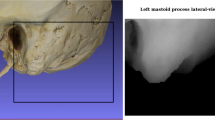Abstract
The suitability of the large collection of skulls of known sex (n♂=357, n⧫=213), housed in the Department of Anthropology of the University of Coimbra, as a reference series for sex diagnosis from skulls, was investigated. This was done by calculating estimates for the maximum «actual discriminatory value for samples being diagnosed». here called Dt max. The estimates for this statistic were found to be relatively low. Depending on the estimation procedure used, values of 1.68 and 1.64, were obtained, which correspond with theoretical percentages of correct classification of 79.8 and 79.3, respectively. An attempt was then made to investigate whether the low level of sexual dimorphism was due to heterogeneity in the series, which was therefore partitioned into Northern, Central and Southern groups according to place of birth. Only in the Southern group was the level of sexual dimorphism found to be slightly higher than in the whole series.
The need for large well documented reference series for deriving techniques for sex determination from the skull and other skeletal elements is discussed and an extensive description of the methods emploved in this study is given.
Similar content being viewed by others
References
Bocquet-Appel J.P., 1984.Biological evolution and History in 19th, century Portugal. In: Multivariate statistical methods in physical anthropology, Reidel, Dordrecht. ed. by G.N. van Vark and W.W. Howells. pp. 289–322.
Cooley W.W. &Lohnes P.R. 1962.Multivariate Procedures for the Behavioral Sciences. Wiley, New York.
Cunha E., 1989.The construction of sex discriminant functions from a large collection of skull of known sex. Unpublished master thesis, University of Coimbra.
Cunha E., 1991. Forthcoming Ph.D. thesis, University of Coimbra.
Ferembach D., Stoukal M. &Schwidetzky I., 1980.Recommendations for age and sex diagnosis of skeletons. Journal of Human Evolution, 9/7: 517–550.
Giles E. &Elliot O., 1963.Sex determination by discriminant function analysis of crania. Am. J. Physical Anthropology, 21: 53–61.
Howells W.W., 1966.Craniometry and multivariate analysis. The Jomon population. A study by discriminant analysis of Japanese and AInu crania. Papers of the Peabody Museum, 57/1 Harvard University, Cambrige, Massachusetts, USA.
Howells W.W., 1969.Criteria for selection of osteometric dimensions. Am J. Phys. Anthrop., 30: 451–458.
Howells W.W., 1973.Cranial variation in man. A study by multivariate analysis patterns of difference among recent human populations. Papers of the Peabody Museum of Archaeology and Etnology. Harvard Univ., Vol. 67.
Kajanoja P., 1966.Sex determination of Finnish crania by discriminant function analysis. Am. J. Phys. Anthrop. 24: 29–34.
Lachenbruch P.A., 1968.On expected probabilities of misclassification in discriminant analysis, necessary sample size and relation with the multiple correlation coefficient. Biometrics, 24/4. 823–834.
Nourisis M.L., 1986. SPSS/Pc+ for the IBM Pc/xt/at SPSS Inc. Chicago.
Schaafsma W. &Van Vark G.N., 1979.Classification and discrimination problems with applications. Part IIa. Statistica Neerlandica, 33/2:91–126.
Svøjold T., 1988.Geschlechtsdiagnose am Skelett. In: Anthropologie, Handbuch der vergleichenden Biologie des Menschen. 444–480. ed. by R. Knussmann, I. Schwidetzky, H.W. Jürgens, and G. Ziegelmayer. Fischer, Stuttgart.
Stewart T.D., 1948.Medico-legal aspects of the skeleton. I. Age, sex race, and stature. Am. J. Phys. Anthrop. 6:315–321.
Ubelaker D.H., 1978.Human skeleton remains. Aldine Publishing Cy., Chicago.
Uytterschaut H.T. 1983.Affinities of Philippine Populations, an application of multivariate techniques to human skull data. Ph D. thesis, University of Groningen.
Van Vark G.N., 1970.Some statistical procedures for the investigation of prehistoric human skeletal material. Ph.D. thesis, University of Groningen.
Van Vark G.N., 1976.A critical evaluation of the application of multivariate statistical methods to the study of human populations from their skeletal remains. Homo, 27/2:94–114.
Van Vark G.N. &Van Der Sman P.G.M., 1982.New discrimination and classification techniques in anthropological practice.Z. Morph. Ant, 73/1:21–36.
Van Vark G.N., 1984.On the determination of hominid affinities. In: Multivariate statistical methods in physical anthropology, Reidel, Dordrecht. ed. G.N. van Vark and W. W. Howells. pp. 323–349.
Van Vark G.N., 1987.An anthropometric approach to the study of evolution. Acta Morphologica Neerlando- Scandinavica, 25/2:107–117.
Author information
Authors and Affiliations
Rights and permissions
About this article
Cite this article
Cunha, E., van Vark, G.N. The construction of sex discriminant functions from a large collection of skulls of known sex. Int. J. Anthropol. 6, 53–66 (1991). https://doi.org/10.1007/BF02447289
Received:
Accepted:
Issue Date:
DOI: https://doi.org/10.1007/BF02447289



